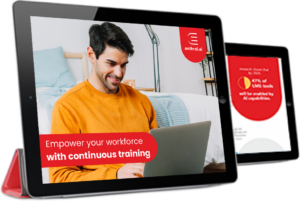LMS vs LXP: Which is Right for Your Organization?

Employees are often encouraged to “develop skills” and “build competencies” to grow in their careers. At first glance, these phrases might seem interchangeable. After all, both relate to improving your professional capabilities.
But here’s the catch: skills and competencies are not the same. Many people use these terms loosely with the assumption that they mean the same thing. However, that isn’t the case and understanding the difference between the two is important.
Skills refer to specific abilities you have learned like things you can do, such as coding, writing, or presenting. Competencies, on the other hand, take it a step further. They include not just skills but also the knowledge, behaviors, and attributes needed to apply those skills effectively in different situations.
So why does this difference between the two really matter? Because today, employers want professionals who not only know how to do something but also have the competency to adapt, collaborate, and think critically to solve real-world challenges.
In this blog, I talk about the key differences between skills and competencies and how it is possible to strategically develop both to future-proof careers.
Also Read: What’s the Difference Between Skills and Competencies?
Hard Skills vs. Soft Skills
Skills can be categorized into two main types:
Hard Skills: These are technical, measurable abilities that can be taught and assessed. Hard skills are often job-specific and can be demonstrated through certifications, training programs, or practical experience. For instance, coding in Python or Java, data analysis using Excel or SQL, graphic design with tools like Adobe Photoshop or even proficiency with a foreign language.
Soft Skills: Soft skills, on the other hand, relate to how you interact, communicate, and collaborate with others. They are often harder to measure but are just as important in the workplace. Soft skills influence teamwork, leadership, and problem-solving abilities. For example, effective communication, adaptability in changing environments, conflict resolution, time management etc.
The Balance Between Hard and Soft Skills
Both hard and soft skills play a key role in careers, but they serve different purposes. Hard skills enable people to perform technical tasks, while soft skills determine how effectively they work with others and navigate professional challenges.
For instance, knowing how to use Excel formulas is a hard skill. It allows you to analyze data and automate calculations. However, effectively collaborating with a team to interpret and present that data requires soft skills like communication and teamwork.
Most employers increasingly look for professionals who have a strong balance of both skill types. While hard skills help secure job opportunities, soft skills help with long-term career success by enhancing a person’s ability to adapt, lead, and thrive in diverse work environments.
What is a Competency?
A competency goes beyond a single skill. It is a broader concept that encompasses skills, knowledge, abilities, and behaviors, all working together to drive high performance in a role. While skills answer the question “what can you do?”, competencies answer “how effectively can you apply those skills in real-world situations?”
Competencies are crucial because they determine not just whether someone can perform a task, but also how well they can do it under different circumstances. They reflect a person’s ability to adapt, think critically, and make decisions in complex scenarios — qualities that are highly valued in the modern work environment.
Competency in Action
To understand competencies in practice, let’s talk about leadership as an example.
A manager needs more than just technical expertise or industry knowledge (hard skills). They must also possess:
- Problem-solving abilities to navigate challenges and make informed decisions.
- Emotional intelligence to understand and manage their own emotions and those of their team.
- Decision-making skills to analyze situations and choose the best course of action.
- Communication and delegation skills to convey expectations clearly and empower team members.
In short, together, all these elements form the competency of leadership which means it’s all a combination of different skills, behaviors, and attributes that define how effectively someone can lead a team and drive success.
While competencies vary across industries and job roles, there are some key examples that apply across many professions like strategic thinking, conflict resolution, adaptability, customer focus etc.

Empower your workforce with continuous training
- Employee Onboarding
- Employee Upskilling
- Compliance Training
Competency vs. Skill: Key Differences
As we saw before, skills and competencies are closely related but not the same. Skills are specific, measurable abilities, while competencies encompass a broader set of skills, knowledge, and behaviors that determine how effectively someone applies those skills in real-world scenarios.
To break it down further, let me put this in a table, comparing skills and competencies side by side:
| Skill | Competency | |
| Definition | A specific ability to perform a task. | A combination of skills, knowledge, behaviors, and attributes that enable high performance. |
| Focus | The “what” – what a person can do.
| The “how” – how well a person applies their skills in a given context. |
| Development | Learned through training, practice, or experience. | Developed through experience, reflection, and a combination of learning and behavior. |
| Assessment | Easy to measure (e.g., coding proficiency, language fluency).
| More complex to assess (e.g., leadership, adaptability, problem-solving). |
| Example | Knowing how to use Excel formulas.
| Using Excel to analyze data, interpret insights, and present findings effectively. |
Choosing the Right Approach: Skills, Competencies or Both?
When deciding between a skills-based or competency-based approach, the right choice depends on your organization’s goals, workforce structure, and long-term talent strategy.
There are platforms like Enthral that are designed to support both models, allowing you to align your learning and development strategy with your company’s unique needs.
If your organization has been using a competency framework for years and isn’t ready for a complete shift, that’s completely fine. You can still enhance standardization, improve workforce agility, and drive experiential learning by incorporating a skills-focused approach alongside your
existing model. By mapping skills to job roles, you can get many of the same benefits that a purely skills-based strategy offers, without overhauling your current system.
Ultimately, there’s no one-size-fits-all solution. What matters most is that your model enables accurate workforce assessment, identifies key development areas, and provides the right learning opportunities to build continuous professional growth. Whether you prioritize competencies, skills, or a hybrid approach, ensuring that your workforce is equipped for the future should remain your central focus.
Final Thoughts
Understanding the difference between competencies and skills is essential so that you can identify skill gaps within your workforce. By mapping out the competencies required for current and future roles, you can pinpoint specific areas where your employees may need additional training or development.











